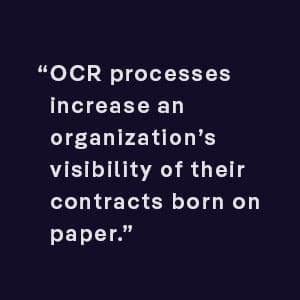Digitizing manual processes is a top priority in 2022. So is streamlining contract-related customer experiences. In parallel, organizations need to continue searching for ways to capture physical agreements. And for many, the best way to do that is running them through optical character recognition (OCR) processes and filing them in a contract repository, along with their electronic counterparts.
The ability to search contracts by metadata, like contract author, supplier, customer, or creation date, is only the start of unlocking the valuable information that exists in your contracts. The earliest commercial use of OCR for retrieval dates back to the 1920s. Emanuel Goldberg repurposed his earlier invention, called the “statistical machine,” which could read characters and convert them into telegraph code. He then created the first electronic document and microfilm retrieval system, which used a photoelectric cell for pattern recognition.
Naturally, OCR in contract management has progressed significantly since its invention. So, we have gathered some of the critical milestones and enhancements for you here.
A Brief History of OCR Technology
For almost a century, the functionality first provided by Goldberg’s statistical machine has been embedded into many document capture and business applications. Many of us take for granted how OCR can ingest text images and transform them into searchable, editable information assets. The OCR process happens so quickly that contracts that were created as paper documents instantly become searchable upon digitization.
Here are five key milestones in the evolution of OCR technology.
1. Document Processing Automation (the 1960s)
The earliest OCR processes could only recognize a limited number of fonts, symbols, and letters. In the mid-1960s, IBM released the 1418 Optical Character Reader, which could identify a broader spectrum of characters and fonts. This technology provider offered skilled technicians to configure the hardware with templates to read defined areas of a document. Today, this capability helps businesses recognize critical zones of legal and business documents, like vendor names, addresses, invoice numbers, and authorized signatories.
2. Smarter and More Diversified OCR (the 1970s and 1980s)
In the 1970s, intelligent character recognition (ICR) was invented. It provided document scanning technology to identify and translate hand-printed text — and, ultimately, cursive writing. OCR engines were enhanced to clean up documents through processes, like deskewing, despeckling, and removing other unwanted “noise” from records.
Zonal OCR advanced in the 1970s, and OCR machines could read essential information from documents, like addresses and postal codes. Kurzweil Computer Products created “omni-font” software that could recognize virtually any character or letter, in any font. Advances were made in capturing data from documents, including credit card receipts, envelopes, and print barcodes on documents associated with them.
In the 1980s, companies began using OCR scanners to read price tags and passports. The use of document scanners and fax machines was widespread, and the use of OCR to capture valuable data from converted files proliferated.
3. Cloud-based OCR (the 1990s and 2000s)
The evolution from hardware-based to software-based OCR processing enabled leading companies, like ABBYY and Accusoft, to license their technology directly to end-user customers. They could also license their OCR tools — on an API or white label basis — to document capture software and scanning hardware companies, like Fujitsu, RICOH, and Xerox. Companies could extract critical data from documents at speeds and accuracy rates never considered possible, before seamlessly importing that data into their operations management systems like ERP.
The ability to save time on manual data entry, contract and document search delivered considerable returns on investment. Accurate, automated data input via OCR prevented traditional transposition errors. Cloud-based OCR contract management then became quicker and more precise, enabling document indexing and content search. Its flexible, open architecture also made it available for both desktop and mobile applications.
Minimizing errors like this helped businesses avoid unnecessary risks and compliance exposures — those resulting from agreeing to contract terms that cannot not be lived up to or are unrealistic in the first place.
As the adoption of web services, open-source, and cloud-based technologies increased, WebOCR emerged as the first OCR engine that did not require the use of licensed scanning software. Many others would follow.
As the API era began, many software developers found it was more affordable and efficient to purchase OCR technology that was fully documented, supported, and maintained by a vendor, instead of building and supporting the technology in-house.
4. Business Process Management, Machine Language, and OCR (the 2010s)
Contract management systems were engineered, in part, to optimize contract-related workflows, like reviews, approvals, negotiations, executions, and renewals. By converting contract text into searchable, indexed data, businesses could run a rules engine query and identify any potentially problematic clauses — like those that would exceed contract value thresholds. OCR processes allowed captured documents to go through the same workflows as those that were born digital.
However, poorly scanned PDF and TIF files were often blurry, and standard OCR engines misinterpreted certain words or character combinations. The good news was enhanced character and pattern recognition — via machine learning (ML) and computer vision — could be trained on document templates to “preprocess” documents. Information workers could then train contract review bots on where certain information was typically located. That way, it could spend more time processing characters, and less time figuring out the layout and structure of a contract or other legal document.
5. Business Process Automation and OCR (the 2020s)
The ultimate aims of legal digital transformation are creating efficiencies, eliminating bottlenecks, and increasing the speed of legal work. OCR in contract management processes increases an organization’s visibility of their contracts born on paper, whether they were brought in during an acquisition or simply sat in storage while day-forward documents were processed.
The bottom line is a shared, searchable repository — of all active and historically pertinent contracts — is essential for corporate memory. The deliverables of a contract may be complete, yet archived contract terms and templates could be very helpful during negotiations of a new venture or as evidence of previous business dealings. And as contract authorship, review, and approval functions are automated, legal professionals can be freed up to work with their colleagues and negotiation partners to move business relationships forward.
Steps Toward Easier Discoverability
If your legal team plans to make business process digitization a priority this year, be sure to enhance your OCR capabilities, especially as they relate to your contract management system. Capturing and converting agreements into searchable digital assets immediately reduces many of the inefficiencies of physical records. That way, you can spend more time on strategic business activities.
Want to find out about other ways to automate contract-related functions? Download our Auto-Contract Desk data sheet today.
Author:

Sarvarth Misra
Connect with us on Linkedin











